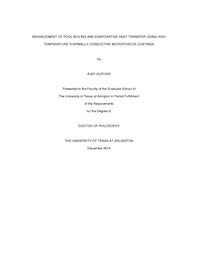
ATTENTION: The works hosted here are being migrated to a new repository that will consolidate resources, improve discoverability, and better show UTA's research impact on the global community. We will update authors as the migration progresses. Please see MavMatrix for more information.
Show simple item record
| dc.contributor.author | Gurung, Ajay | en_US |
| dc.date.accessioned | 2015-07-01T17:50:35Z | |
| dc.date.available | 2015-07-01T17:50:35Z | |
| dc.date.issued | 2014-12 | |
| dc.date.submitted | January 2014 | en_US |
| dc.identifier.other | DISS-12958 | en_US |
| dc.identifier.uri | http://hdl.handle.net/10106/24967 | |
| dc.description.abstract | The present research is an experimental study of the enhancement of pool boiling and evaporative heat transfer using high temperature thermally conductive microporous coatings. Two major types of coatings were investigated: one that is based on copper powders on copper substrate and the other on aluminum powders on aluminum substrate. Both coatings were easy to fabricate with low costs compared to conventional sintering and plasma spraying techniques, yet have high bonding strength and some of them can operate at temperatures up to 670 oC. Multiple coating options were fabricated and tested in pool boiling of water in order to optimize the coating. These coating options consisted of variations of coating composition ratio, coating thickness and powder sizes. Average powder sizes ranged from 5 µm to 110 µm, and coating thicknesses from 75 µm to 340 µm, applied on flat 1x1cm2 test heaters. The heaters were tested in the horizontal, upward-facing orientation in saturated conditions at atmospheric pressure and under increasing heat flux. Pool boiling results revealed an optimum composition, powder size and thickness for each coating types. The maximum enhancement in boiling heat transfer coefficient obtained from copper microporous coatings was up to 8.7 times relative to a plain copper test surface and nearly doubled the critical heat flux while aluminum microporous coatings enhanced boiling heat transfer coefficient by 3.5 times compared to plain aluminum surface without any further enhancement in CHF. This enhancement was ascribed to the numerous microcavities of optimum shape and size formed within the porous matrix of the coating. The detail microstructures of the coatings from the top surface as well as cross-sections are also presented through optical microscope and SEM images. The optimized aluminum coatings were also explored on fluids other than water such as acetone and HFE-7100 for their boiling heat transfer enhancement. Furthermore, the same coatings were applied on evaporative spray and jet-impingement tests using water to broaden the application of aluminum microporous coatings in evaporative cooling technology. | en_US |
| dc.description.sponsorship | Moon, Hyejin | en_US |
| dc.language.iso | en | en_US |
| dc.publisher | Mechanical Engineering | en_US |
| dc.title | Enhancement Of Pool Boiling And Evaporative Heat Transfer Using High Temperature Thermally Conductive Microporous Coatings | en_US |
| dc.type | Ph.D. | en_US |
| dc.contributor.committeeChair | Moon, Hyejin | en_US |
| dc.degree.department | Mechanical Engineering | en_US |
| dc.degree.discipline | Mechanical Engineering | en_US |
| dc.degree.grantor | University of Texas at Arlington | en_US |
| dc.degree.level | doctoral | en_US |
| dc.degree.name | Ph.D. | en_US |
Files in this item
- Name:
- Gurung_uta_2502D_12958.pdf
- Size:
- 2.041Mb
- Format:
- PDF
This item appears in the following Collection(s)
Show simple item record


